2.
GHANA
Emerging trade partners push African manufactured
exports up
African exports of manufactured goods have doubled over
the last ten years with the rise in demand for goods by
emerging trade partners, says a new report.
According to the African Economic Report the share of
trade conducted by the continent with emerging partners
has grown from approximately 23 per cent to 39 per cent
in the last decade.
The report shows that China replaced the US in 2009 as
the main Africa's trading partner. Africa's top five
emerging trade partners include China (38 per cent), India
(14 per cent), Korea (7.2 per cent), Brazil (7.1 per cent)
and Turkey (6.5 per cent).
However, the European Union and the US remain the most
important sources of Foreign Direct Investment for
African countries, says the report.
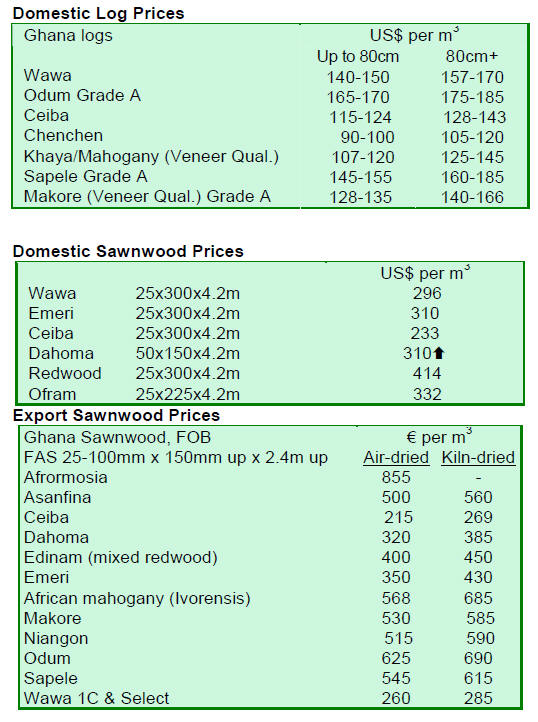
African countries to deliver free access to trade-related data
In other trade related news, the African Development
Bank (AfDB), the International Trade Centre (ITC), the
UN Conference on Trade and Development (UNCTAD)
and the World Bank, in cooperation with the UN Statistics
Division (UNSD), today launched the Transparency in
Trade Initiative (TNT), a global programme that will give
more access to influential trade data.
Free access to data will make it easier for exporters and
policy-makers to meet relevant standards and requirements
and therefore prevent rejection of their exports at
destination. The data will also allow for better monitoring
and analysis of trade-related projects.
"Increasing transparency in trade will improve the trading
environment in Africa and in Africa's export markets; it
will facilitate the continent's exports to both regional and
international markets," said Donald Kaberuka, President of
the African Development Bank. "The launching of the
Transparency in Trade Initiative is thus a most welcome
development."
For more see:
http://allafrica.com/stories/201107190904.html
3.
MALAYSIA
Malaysia accounts for the world¡¯s largest certified
tropical forest says MTCC
The Malaysian Timber Certification Council (MTCC) says
that there are 5 million ha. of certified tropical forest in
Malaysia, making this the world¡¯s largest on record.
Only 10% of the world¡¯s commercial forests, that is 375
million ha. have been certified to date. About 53.8% of the
certified forests are in North America, 34.4% in EU
countries and a mere 2.1% in the Asia-Pacific region.
Malaysia is also one of the leading exporters of certified
timber products with monthly exports of up to 7,000 cu.m
of certified timber products, mainly in the form of
laminated finger-jointed products, plywood, sawnwood
and timber mouldings.
Up to March 2011 a total of 463,730 cu.m of certified
timber products have been exported to 22 countries.
Procurement policies drive demand for certified wood
The MTCC says that certified timber products earn a
premium of between 2% to 4% in the Netherlands, one of
Malaysia¡¯s main markets for timber products.
The Netherlands and nine other countries, Belgium,
Denmark, Finland, France, Germany, Japan, New Zealand,
Switzerland and the UK have enforced public procurement
policies that encourage the acceptance of certified timber
products for publicly funded projects.
Likewise, large DIY store chains such as Home Depot in
the US and B&Q in the UK have mandated the
procurement of certified timber products in their corporate
procurement policies.
In addition, a growing number of green buildings schemes
on both sides of the Atlantic are placing a greater
emphasis on timber products certified under PEFC
(Programme for the Endorsement of Forest Certification)
or Forest Stewardship Council (FSC).
There were nine certified forest management units (FMUs)
holding valid PEFC schemes certificate for forest
management in Malaysia as of July 1, 2011.
PEFC began endorsing the Malaysian Timber Certification
Scheme (MTCS) in 2009 and will continue to do so over
the next five years.
Appeal against anti-dumping duties on plywood
The Sarawak Timber Industry Development Corporation
(STIDC) will assist Malaysian plywood producers in
appealing against the anti-dumping duties being applied by
the South Korean government on Malaysian plywood.
Eight of the nine plywood producers affected by the antidumping
duties are from Sarawak.
The STIDC will monitor the pricing of plywood until
February 2012, after which the appeal would be lodged.
The purpose of the price monitoring is to show that any
suggestion of dumping has not existed for 12 months.
STIDC has advised plywood producers affected by the
anti-dumping duties that they could file for a review
through the Ministry of International Trade and Industry
(MITI) after a one year period.
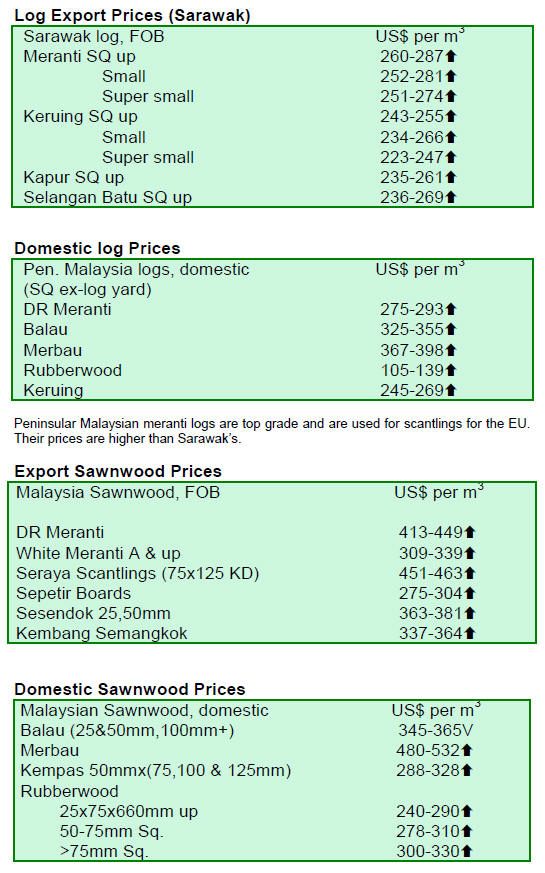
4.
INDONESIA
EU Markets will close to
non-certified products
The Indonesian timber industry could find its wood
products being excluded from the European Union
markets and severely restricted in the US as well as in
Japan if manufacturers do not move quickly to secure
timber certification.
The Indonesian government has signed a VPA with the
EU and this is likely to be ratified in September this year
after which enforcement of the Wood Legality
Verification System is set to begin in March 2013.
Markets in Japan at risk too
Apart from the lack of certification, reports suggest that at
present only 2 plywood manufacturers out of the 40 in
Central Java meet the Japan Agriculture Standard (JAS)
for timber and timber products to be used for building
materials.
Timber products manufacturers have been advised to
acquire the appropriate timber products certification as
soon as possible to avoid any loss of market share in the
EU, USA and Japan.
Investments for environmentally sustainable green
prosperity
The US State Department has indicated that Indonesia
could secure millions in financial aid over the next few
years for the development of a sustainable and green
economy.
Indonesia stands to gain $600 million over the next
five
years under the Millennium Challenge Corporation
compact for investments in environmentally sustainable
green prosperity.
Currently, the two countries are working to complete a
second agreement on forest conservation before
September 2011. The US State Department will contribute
$20 million towards the fulfilment of that agreement.
Specialty furniture market in US remains firm
The demand for Indonesian timber products is growing
with timber merchants and manufacturers receiving more
orders and enquiries from China, India, Japan and South
Korea.
With the coming of the Muslim fasting month, many
Middle-Eastern importers are also keen to have contracts
concluded before the fasting month begins, triggering one
of the sharpest rise in prices for Indonesian timber
products in 2011.
Indonesian furniture manufacturers added that while
demand in the US market is still weak, orders for specialty
furniture and hand-made furniture are growing.
Although the US financial crisis may have hit most
consumers in the middle income band, the upper-middle
class band of consumers still have money for remodeling
during the summer vacation season.
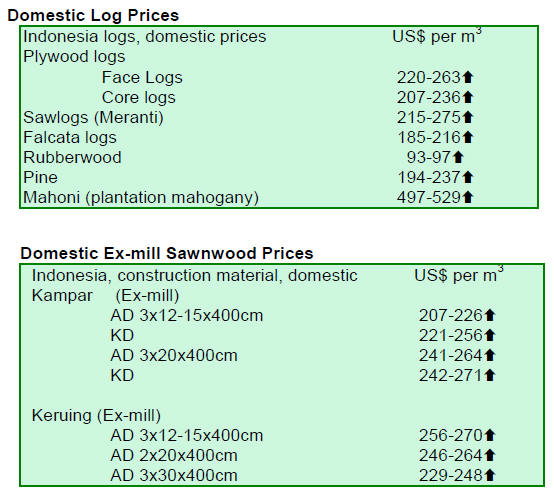
5. MYANMAR
India is the main destination for
ocean shipments of
hardwoods from Myanmar
During the first quarter of the current fiscal year more than
80 per cent of all shipments of both teak and other
hardwoods from ocean ports in Myanmar went to India.
Less than 20 per cent was shipped by sea to China,
Thailand, Vietnam, and Bangladesh. Records of the cross
border timber trade with China are not available. India is
by far the most important market for both teak and
hardwoods from Myanmar.
About 70% of non-teak hardwood shipments last year
went to India, followed by Bangladesh, China and
Vietnam and about 80 % of teak went to India, the
remaining 20% was shipped to Thailand, China and
Vietnam.
Appreciation of the Kyat wipes out gains from
export tax reduction
The government¡¯s decision to reduce the export tax by 3
per cent beginning this month (July 2011) has been
welcomed by the private sector. However, exporters feel
that the reduction should be much more than 3 per cent.
Opinions differ concerning how much the reduction
should be.
The local timber industry says the export tax on
processed
added value wood products should be minimal. Some
argue that if the government wants to tax timber exports
then the levy should be on log exports. They argue that
this would reduce sales of logs and help the development
of the value added sector in the country.
Despite the reduction of 3 percent the exporters
claim they
have gained little since the Myanmar Kyat has appreciated
about 20 percent against the US dollar within one year.
The state owned newspaper, the Mirror Daily, has
reported
that during a meeting with the executive committee of the
Myanmar Bankers Association the Union Finance
Minister reportedly said that arrangements are underway
to determine exchange rates for the Myanmar kyat that are
stable as well as beneficial for the country.
Until concrete and viable results emerge, the
business
circle is said to be facing difficulties adjusting to the new
exchange rate.
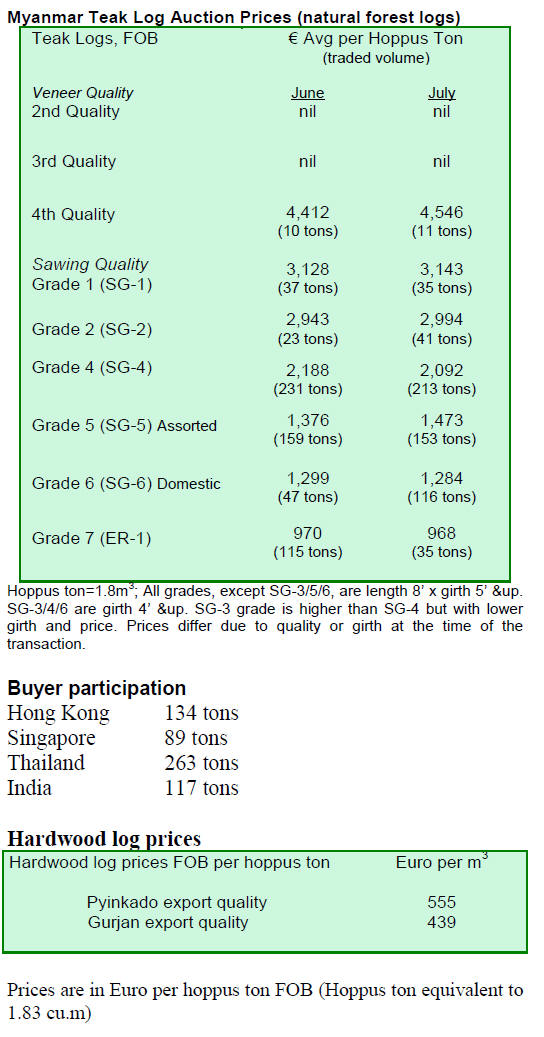
6. INDIA
Inflation fears prompt another
interest rate hike
Analysts report that inflation in India is expected to remain
high until year end. Annualised inflation grew to over 9
per cent in June largely due to the rising costs of
manufactured products and gasoline.
In its latest meeting the Reserve Bank of India
raised its
key interest rate by half a percent, the 11th rise in less than
a year and a half. In a statement the Reserve Bank said
that inflation remains the country¡¯s main economic
concern.
Interest rates have been raised 10 times since March
2010.
High inflation is increasing the cost of servicing loans as
well putting pressure on companies with regards to raw
material costs and wages.
Export performance sustained
Figures released by Ministry of Commerce indicate a rise
of 46% in exports during the month of June 2011 to
US$29 billion. At the same time imports rose by 42
percent compared to the figures a year ago to reach US$36
billion. This is despite experts doubting the sustainability
of such high growth due to uncertainty in global markets.
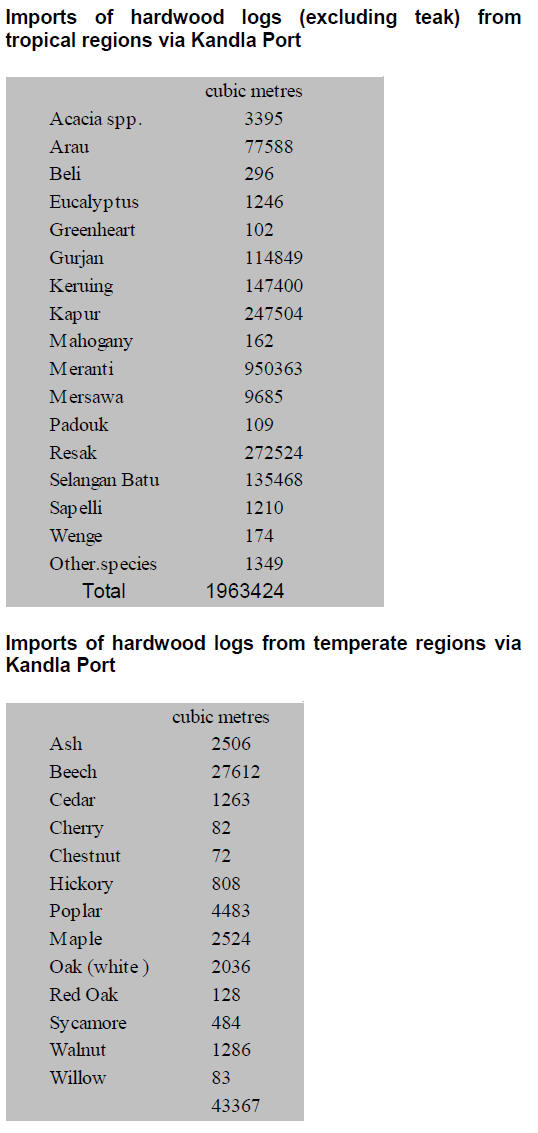
Log auctions suspended with onset of monsoon
In the last phase of log sales in Western Indian timber
depots, approximately 12,200 cubic meters of Teak and
other hardwoods were sold.
The monsoon has now arrived in this region and the
next
series of auctions will start from October when the
monsoon should be over. Central Indian depots will have
one more round of sales of Teak logs before auctions are
also suspended.
Teak and hardwood log prices continue upward
trend
Demand was buoyant at the W. Indian depots and the
prices achieved above previous levels.
Shipbuilding quality Teak lots have fetched
Rs.2200~2400
plus per cubic foot, good quality sawing grade was traded
at Rs.2000 per cubic foot, medium quality saw logs
fetched Rs.1700~1800 per cubic foot and average quality
logs changed hands at around Rs.1500 per cubic foot.
Demand for Haldu ( Adina cordifolia ) Laurel (
Terminalia
tomentosa ) and other hardwood logs has also been firm
and prices were in the region of Rs.500~600 per cubic foot
for good quality logs, Rs.400 for medium quality and
around Rs.300 per cubic foot for average quality logs.
During the monsoon season in India the industry
becomes
more dependant on imported logs.
Low cost homes from Tata
Media reports say that the Tata group will begin
construction of a new style low cost house which can be
erected over seven days and will cost only Euro 500.
Prototypes are currently being tested and the homes
could
be available next year. It is well known that in rural areas
millions of homes are needed. The company also has plans
for a larger and slightly expensive home.
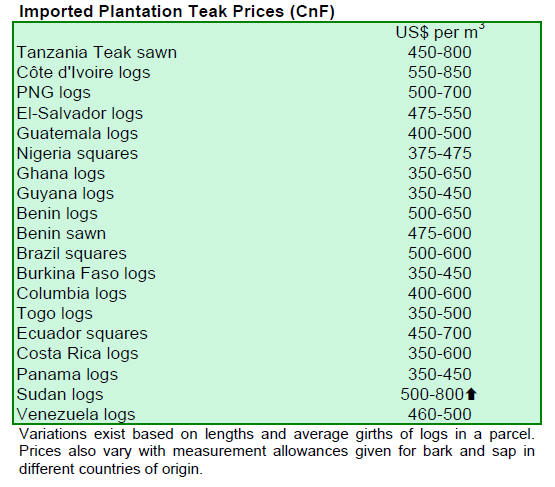
Demand from Europe, USA and Middle East for teak and
other hardwoods remains steady.
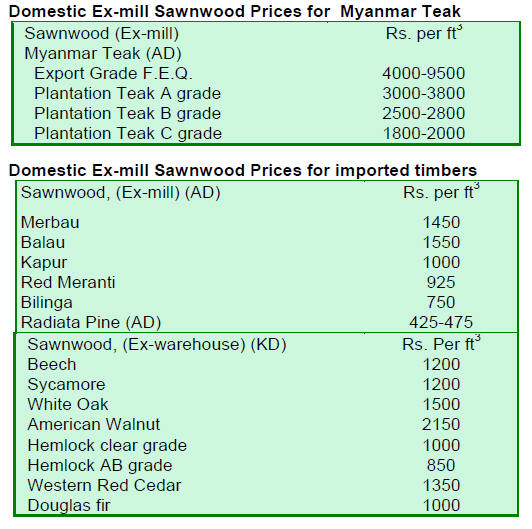
7. BRAZIL
Brazilian Real continues to
appreciate
Prices for wood products in the domestic market in local
currency remain relatively stable and are unchanged over
the past month but when prices are converted to US
dollars there was an average increase of around 3% due to
the appreciation of the Brazilian currency against the U.S.
dollar.
Interest rates rise in face of inflation
The official inflation rate measured by the Brazilian
National Consumer Price Index (IPCA) decelerated to just
0.15% in June. In May, the IPCA rose 0.47%. Over the
past 12 months, however, the accumulated rate amounted
to 6.7%, well above the upper limit of 6.5% for 2011set by
the Central Bank.
The Monetary Policy Committee (Copom) raised the
prime interest rate (Selic) by 0.25 percentage point to a
total of 12.50% per year. The next Monetary Policy
Committee meeting is scheduled for late August.
¡°Timber is Legal¡± programme celebrates two years
of operation
The programme ¡°Madeira ¨¦ Legal¡± (Timber is Legal)
which was launched in 2009 is an initiative that brings
together the Union of Construction Industry of Great
Structures of State of São Paulo (SindusCon-SP), WWFBrazil,
the Sao Paulo State Government and the Sao Paulo
City Hall, as well as 19 public bodies and private
companies.
The city of Sao Paulo was the first municipality to
join the
¡®Friends of the Amazon City Program¡¯ as early as 2005.
Since then, all public construction in the city uses only
verified legal timber. The city also pioneered the
requirement for verification of the legal origin of timber
used in furniture provided to City hall.
The support of the construction sector in Sao Paulo
has
been essential in encouraging the use of verified legal or
certified timber as it is estimated that of the timber used in
state construction some 15% is from the Amazon.
Timber identification and monitoring database
The Mato Grosso Institute of Agricultural Economics
(IMEA), together with research teams from the Forest
Base Data Platform project, coordinated by the Center of
Timber Producer and Exporter Industries of Mato Grosso
(Cipem), have started forest and timber surveys to collect
data for a new database that will strengthen the capacity
for overseeing the timber sector in the state.
About 500 companies out of a total of 1,680 in the
region
as well as regulatory institutions such as the Secretariat of
the Environment (SEMA), the Secretariat of Finance
(SEFAZ), and the Brazilian Institute of Environment and
Renewable Natural Resources (IBAMA) will be surveyed.
The methodology to be used in Mato Grosso will be
presented for future application in the state of Amazonas
and in other states in the North of the country.
Pine sawnwood the only bright spot in Brazil¡¯s
June export earnings
In June 2011, the value of wood product exports (except
pulp and paper) fell 1.4% compared to values in June
2010, from US$ 206.2 million to US$ 203.3 million.
However, pine sawnwood exports increased 19.5% in
value in June 2011 compared to levels in June 2010,
jumping from US$ 12.8 million to US$ 15.3 million. In
terms of volume, exports increased 17.3%, from 55,500
cu.m to 65,100 cu.m over the period.
Double digit declines in earnings from plywood,
sawnwood and furniture
Exports of tropical sawnwood fell both in volume and in
value, from 38,500 cu.m in June 2010 to 33,900 cu.m in
June 2011 and from US$ 17.9 million to US$ 16.7 million,
during the same period. This equates to a 7% decline in
value and a 12% decline in volume.
Pine plywood exports fell 29% in value in June 2011
compared to June 2010, from US$ 36.5 million to US$
26.0 million. In volume, the decline was a massive 33%
during the same period, from 97,600 cu.m to 65,100 cu.m.
Exports of tropical plywood also fell from 8,700
cu.m in
June 2010 to 6,800 cu.m in June 2011 and this represents a
22% decline. In terms of value a 16% drop was observed,
from US$ 4.9 million to US$ 4.1 million.
Wooden furniture export dropped from US$ 46.4
million
in June 2010 to US$ 38.5 million in June 2011,
representing a 17% decline.
Increasing domestic and export demand for legal
timber
The United States and European countries require roof of
the legal origin of wood products imported. In 2009, North
American and Europe accounted for about 70% of the
Brazilian wood product exports. Moreover, domestic
consumers who consume about 80%of the timber from the
Amazon now show signs of increasing awareness about
the consumption of legal timber.
These developments have acted as a stimulus for the
production of verified legal tropical timber in the country.
Companies with forest concessions in publicly owned
forest must produce timber in a sustainable manner.
Estimates by the Brazilian Forest Service show that 10
million hectares of public forests in National Forests could
meet 20% of the worldwide demand for tropical timber.
Fall in furniture exports from Santa Catarina
According to the Santa Catarina Industry Federation
(FIESC), furniture exports in the state fell 19.7% in the
first half of 2011, compared to the same period of last
year.
According to the Construction and Furniture
Industry
Union of Rio Negrinho (Sindicom), the unfavourable
exchange rate has significantly reduced the export
competitiveness of companies in foreign markets.
Despite gains in productivity and cost savings the
sector
lacks competitiveness as result of the continuous
appreciation of the Brazilian Real.
Moreover, according to the Union furniture designs
are
commonly provided to Brazilian manufacturers by buyers
in each export market and this trend has limited the design
capacity of the Brazilian manufacturer.
Consequently, Brazilian furniture makers have
difficulties
in reorienting products to different export markets or even
to the domestic market.
To overcome this analysts point out that domestic
companies need to invest in research and development of
new designs and new products.
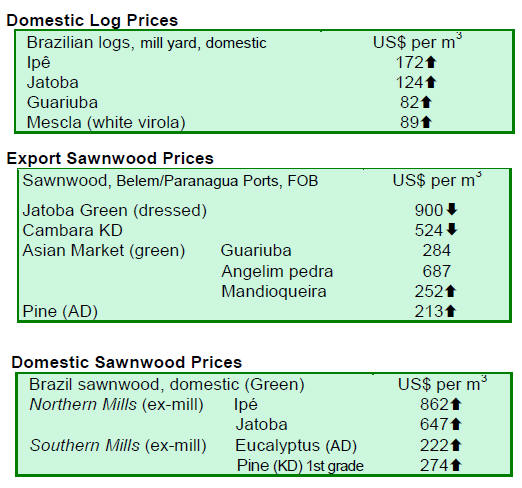
8. PERU
US reaction to new Forestry and
Wildlife law
The Peruvian Congress recently passed a new Forestry and
Wildlife Law. In response to this the office of US
Ambassador Ron Kirk issued the following press release:
¡°This law sets out key reforms called for under the
United
States-Peru Trade Promotion Agreement (PTPA) Annex
on Forest Sector Governance aimed at combating illegal
logging and illegal trade in wildlife.
Passage of this law is the result of significant
work and
extensive consultations with Peru¡¯s indigenous and local
communities, and represents a milestone in Peru¡¯s
implementation of its PTPA environmental commitments.
We welcome passage of this important law and look
forward to continuing to work with the Government of
Peru to further implement its PTPA commitments.
The United States has worked closely with Peru over
a
period of two years while it developed legal provisions to
strengthen forest sector governance as called for under the
PTPA Annex on Forest Sector Governance.
In addition to passage of the Forestry and Wildlife
Law,
the Government of Peru has made other unprecedented
changes to its legal and regulatory regimes to implement
its commitments under the Annex, including amending its
Criminal Code to increase penalties for forest, wildlife and
environmental crimes and assigning ecological police
officers and prosecutors to regions in Peru.
It also created a Ministry of Environment to take
the lead
on natural protected areas and to assume other important
environmental duties.
We look forward to working closely with the
Government
of Peru as it works to fully implement the Annex on Forest
Sector Governance¡±.
The Environment Chapter of the US - Peru Trade
Promotion Agreement
The Annex on Forest Sector Governance, part of the
Environment Chapter of the United States - Peru Trade
Promotion Agreement (PTPA), is the first set of provisions
in any U.S. trade agreement that identifies specific action
required to address an environmental concern, in this case,
the improvement of forest sector governance.
The PTPA is also the first trade agreement in which
the
environmental obligations are subject to the same state-tostate
dispute settlement procedures, remedies, and
sanctions as commercial obligations.
The Annex on Forest Sector Governance reflects the
commitment of both countries to take concrete measures
to combat trade associated with illegal logging as well as
illegal trade in wildlife and further promote sustainable
management of Peru's natural resources.
The Government of Peru conducted extensive
consultations with indigenous and local communities and
other stakeholders in Peru in the lead up to passage of the
Forestry and Wildlife Law, including three rounds of
national consultations in Lima and numerous outreach
sessions in affected regions and communities throughout
Peru.
The office of the US Trade Representative has
indicated it
will continue to keep the U.S. Congress and relevant
stakeholders apprised of Peru¡¯s progress on
implementation.
See http://www.ustr.gov/about-us/press-office/pressreleases/
2011/june/statement-ambassador-ron-kirkpassage-
perus-forestry
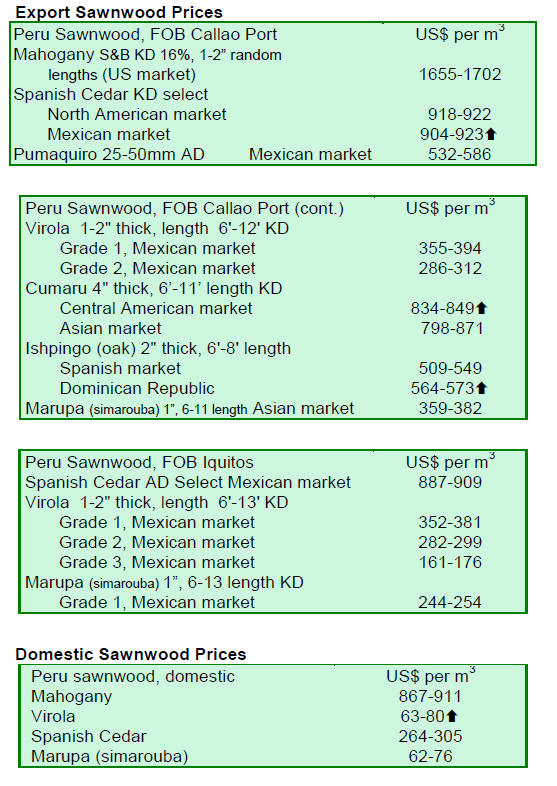
9.
GUYANA
Guyana logs continue to
attract good prices
During the period under review there were no exports of
Greenheart logs.
Purpleheart logs were exported and the standard
sawmill
quality logs attracted good prices. Prices for fair and small
sawmill quality Purpleheart logs only managed to sustain
levels achieved over the previous two weeks. Similarly,
Mora prices also held firm for all categories of logs
(standard, fair and small).
Purpleheart sawnwood prices trend down
Prices for both undressed and dressed sawn lumber were
marginally up on earlier levels and this was most
noticeable for undressed Greenheart which recorded price
gains for all qualities except Prime.
Prices for undressed Greenheart (select) moved up
to a
high of US$ 1,018. This compares with the previous price
of US$ 827 per cubic metre.
Undressed Greenheart (sound) also enjoyed high
prices of
US$ 954 per cubic metre. Similarly, Undressed
Greenheart (sound) prices moved up from US$ 600 to US$
806 per cubic metre.
In contrast to the positive performance of
Greenheart in
the market, undressed Purpleheart prices fell in the (select)
and (merchantable) sawmill qualities during the period
under review.
Undressed Mora prices moved in a narrow range and
prices for select and merchantable sawmill qualities
continued to be firm.
Dressed Greenheart prices were very favourable
increasing from US$ 850 to US$ 890 per cubic metre.
Dressed Purpleheart also showed similar price activity
with its top-end prices moving positively upwards from
US$ 954 to US$ 1,060 per cubic metre.
Plywood exports continue amid easing prices
Plywood exports continue but in recent weeks prices have
eased for BB/CC quality dropping from US$ 690 to US$
600 per cubic metre.
LUS and minor products catching the eye of
buyers
The Guyana Forestry Commission (GFC) is reporting that
sawnwood from many of Guyana¡¯s lesser used species of
lumber continues to catch the attention of the overseas
markets in Asia, the Caribbean, Europe and North
America. These timbers are reportedly used for internal,
external and structural end-use applications.
This encouraging development can stimulate the
processing of a wider range of timbers and increase the
contribution of the value adding and down-streaming
processing of logs and lumber within Guyana¡¯s forest
industry.
The other value added products exported include
craft
items, doors, non-timber forest products and spindles. All
made a noteworthy contribution towards the total export
earnings attracting buyers in the main markets of the
Caribbean and North America.
Industry capacity building initiative underway
The GFC is working to upgrade the capacity of the wood
processing industry through capacity building. Efforts are
directed at the development and adoption by industry of a
code of practice for wood processing and planning skills
development for the wood processing sector.
A draft capacity building plan and guidelines for
the
implementation of the code of practice have been prepared
and will soon be the subject of a stakeholder review.
To provide background data for the GFC initiative
recovery studies were conducted to assess the current level
of efficiency of operations, profitability and
competitiveness in relation to raw material source, quality
and species, applied technology and operator experience
and skill level. National consultations were conducted to
prepare a draft plan and a draft of the code was prepared
detailing the ¡°best practices¡± that were identified for
conditions in Guyana.
The GFC says that with the completion of the second
review process the draft will be sent for ¡°Peer review¡±
both locally and internationally. After this process work
will move to national consultations on training and
implementation.
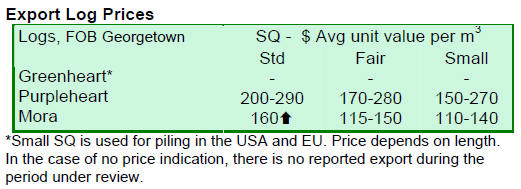
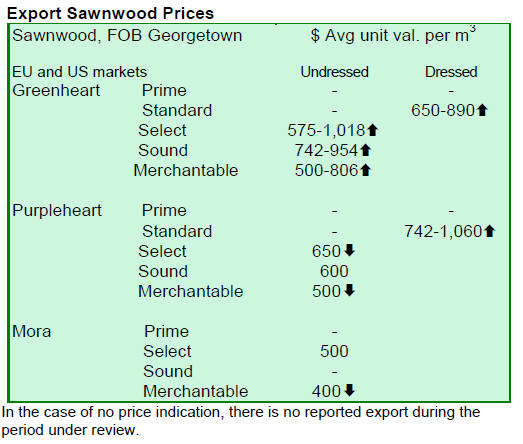
¡¡
Related News:
¡¡